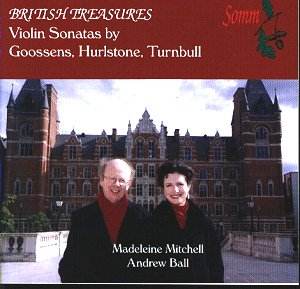Something
of a rebel as a Royal College of Music (RCM) student, Eugène
Goossens recalled, in his autobiography, Overture and Beginners,
that, Stanford, his teacher regarded him as ‘a lost soul’ for
listening to such ‘pornographic rubbish’ as Richard Strauss’s
Elektra. Undeterred, Goossens went on to absorb such ‘modern’
idioms as well as those of Debussy and Ravel in his works including
this deliciously melodic and romantic sonata, written in 1918
and first performed at the Wigmore Hall by Albert Sammons (its
dedicatee) and William Murdoch on 1st May 1920. Goossens
remembered that the première was a great artistic success
‘They play it con amore’ and he was so impressed by the
artists’ performance that ‘he despaired of ever hearing it played
that way again.’ I doubt very much if he would have anything but
praise for Mitchell and Ball’s intensely heartfelt performance;
so poetic in that lovely central Molto adagio and
so invigorating in the breezy final Con brio.
Another
precocious RCM student, William Hurlstone, died at the
tragically early age of 30. He is best remembered for his Piano
Concerto and Fantasie-Variations on a Swedish Air (both
to be heard on one precious album recorded by Lyrita Recorded
Edition SRCS100 many years ago, alas no longer available). He
composed a number of chamber works including a rather eccentric
Phantasie Quartet in E minor that won him the 1905 Cobbett
Prize (another Lyrita album SRCS117 still consigned to vinyl perdition).
This Violin Sonata in D minor was first performed at the Royal
College of Music (pictured on the album cover above behind the
two soloists) on 3rd February 1897. The mood is more
introspective than the Goossens work with a shadowy thread through
its melodiousness. A juxtaposition of sustained melancholic lyricism,
and livelier dance material constitutes the central movement effectively
combining elements of slow movement and scherzo. The final Allegro
scherzando brings sunnier, sprightly music with some quirky
harmonic progressions offering contrasting depth, and surely there
is a passing hint of Elgar in Chanson de matin mood.
Percy
Turnbull, the third RCM student featured in this recital,
studied composition with Holst, Vaughan Williams and John Ireland,
besides attending classes with Dunhill, Dyson and R.O. Morris.
Winning the Mendelssohn Scholarship and the Arthur Sullivan Prize
he won the approbation of his teachers. He became highly regarded
as a recitalist at the RCM, at the Wigmore Hall, and as an accompanist
in the early days of British radio. His one and only extended
instrumental work, this Violin Sonata, was composed in 1925. It
was first performed on 24 June at the RCM with the composer at
the piano partnering Marie Wilson. It then languished until it
was revived in 1983 by Ann Hooley and Robin Bowman at the University
of Southampton. There is an attractive out-of-doors freshness
about the opening lyrical Allegro (but with a sombre melody low
in the violin’s compass) which like the Goossens work nods towards
Debussy and Ravel - and John Ireland. The violin’s yearning melancholy
and drooping piano chords, suffuses the lovely central Andante
moderato that leads to a passing defiant statement by the piano.
Turnbull’s playful Finale recalls Ravel particularly in the piano
writing but it is the violin’s lovely nostalgic central song that
haunts.
Three
gorgeously, lyrical, romantic British violin sonatas played with
great affection by Madeleine Mitchell and Andrew Ball. Highly
recommended.
Ian
Lace
